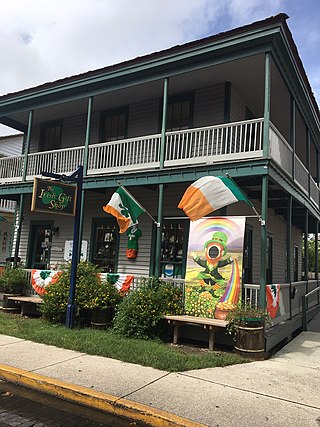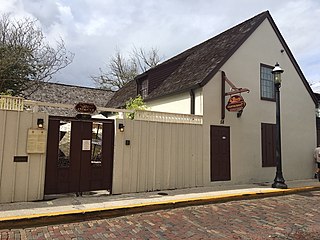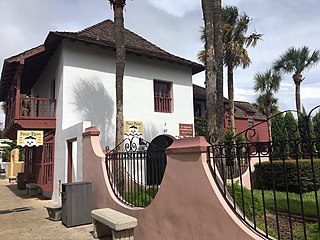
The Joaneda House is located at 57 Treasury Street in St. Augustine, Florida. It was restored to be an example of a Second Spanish Period (1784-1821) residence. It is one of the oldest buildings in Florida.

The Joaneda House is located at 57 Treasury Street in St. Augustine, Florida. It was restored to be an example of a Second Spanish Period (1784-1821) residence. It is one of the oldest buildings in Florida.
The Joaneda house was built around the year 1806 out of wood and was originally owned by Juan Joaneda, a Minorcan fish farmer. [1] The house had a wooden floor. Joaneda then rebuilt the house out of coquina and sold it for a profit to a Juan Gonzáles Montes de Oca. Around 1809, Montes de Oca sold the house to the son-in-law of Juan Joaneda. [2] The house's main entrance was the through the yard and the entire property was enclosed by a wall and fence, reconstructed in 1976. There were originally three rooms on the first floor with an open porch on the south side.
In 1888 the building was used as a tailor shop and the main entrance moved to the street. In the 1920s the Montgomery sisters turned the Joaneda House into a gift shop. They enclosed the porch and built a six-room addition to the south that doubled the size of the building. They also put in a concrete tile floor. [3]
In 1972, the sons of Elizabeth Morley Towers bought her the Joaneda House for $35,000. [4] Towers was a member of the Historic St. Augustine Preservation Board (HSAPB) and donated the house to the Board. The Joaneda House Development Project began in 1976 and was completed in 1977. Archaeological excavations on the lot were completed before restoration work began, in 1975. [5] The cost of the project was $82,476. The purpose of this restoration project was to display an example of a Second Spanish Period residence in downtown St. Augustine and to also provide accommodation for people associated with the Historic St. Augustine Preservation Board. Restoration work was supervised by HSAPB Director of Research Robert Steinbach. [6]
Today the Joaneda House operates as a restaurant and wine shop. The building is owned by the State of Florida and managed on its behalf by University of Florida Historic St. Augustine.

Government House, also known as Governor's House, is located at 48 King Street in St. Augustine, Florida, adjacent to the Plaza de la Constitución. The building, constructed of coquina, served as the governor's official residence from c. 1710 during the First Spanish Period (1565–1763), throughout the British Period (1763–1784), and until 1812 in the Second Spanish Period (1784–1821). Governor Gonzalo Méndez de Canzo was the first governor to build his residence on the present Government House site in 1598.

The Oliveros House is located at 59 St. George Street, St. Augustine, Florida. It was built of coquina during the Second Spanish Period in Florida (1565-1763). Today it is a reconstructed building, standing on original foundations which were unearthed during archaeological excavations.

The Historic St. Augustine Preservation Board (HSAPB) was a state agency in Florida that participated in the restoration and preservation of historic buildings in St. Augustine, Florida from 1959 to 1997. Created in 1959 by Governor LeRoy Collins, the agency acquired, restored, and preserved historic structures in St. Augustine until its abolishment by the State of Florida in June 1997.

The Old Blacksmith Shop is located at 26 Charlotte Street in St. Augustine, Florida. It is a reconstruction of an outbuilding located on the site during the British possession of Florida.

The Triay House is a historic property located at 31 St. George Street in St. Augustine, Florida. It is a reconstruction of the First Spanish Period structure that stood on the site.

The Sánchez de Ortigosa House is located at 60 St. George Street, St. Augustine, Florida. It is a reconstruction of a home dating from the First Spanish Period (1565-1763) that stood on this site.

The Arrivas House is located at 46 St. George Street, St. Augustine, Florida. It was the first completed restoration project of the Historic St. Augustine Preservation Board (HSAPB), and was named after early owner Don Raimundo de Arrivas.

The Cerveau House is located at 26 Cuna Street in St. Augustine, Florida. It is an original house, constructed in the 19th century.

The Florida Heritage House is located at 1 Aviles Street, or 11 King Street, in St. Augustine, Florida. It is a reconstruction of a late Spanish colonial-style house built in the 19th century.

The Gómez House, located at 27 St. George Street in St. Augustine, Florida, is a reconstruction of a simple wooden house dating back to Florida’s First Spanish Period (1565-1763).

The De Mesa-Sánchez House is located at 23 St. George Street in St. Augustine, Florida. It is a restoration of a home dating back to East Florida's First Spanish Period.

The Luciano de Herrera House is located at 58 Charlotte Street in St. Augustine, Florida. It is a reconstruction, depicting a house from St. Augustine's Second Spanish Period (1784–1821).

The Ortega House is located at 70 St. George Street in St. Augustine, Florida. It is a reconstructed home representing the architectural style of the First Spanish Period (1565-1763) in Florida.

The Marin-Hassett House is located at 97 St. George Street in St. Augustine, Florida. It is reconstructed on its foundations that date to St. Augustine's First Spanish Period.

The Salcedo House and Kitchen are located at 42 and 42 1/2 St. George Street, in St. Augustine, Florida. They are reconstructions of 18th century structures that stood on these sites in St. Augustine's First Spanish Period (1565–1763).
Earle W. Newton, II (1917–2006) was a historian, preservationist, publisher, educator, and art benefactor.

The Hispanic Garden is a garden in St. Augustine, Florida owned and maintained by the St. Augustine Foundation, Inc. It is closed to the public and is only opened for special city events,.

Elizabeth Towers (1899–1985) was an American philanthropist and socialite known for her dedication to historic preservation in Northeast Florida.

The Casa del Hidalgo is located at 35 Hypolita Street, at the southeast intersection of Hypolita and St. George Streets in downtown St. Augustine, Florida. It was constructed in 1965 and housed the Spanish government's official exhibition and cultural center.

The Paredes-Dodge House is located at 54 St. George Street in St. Augustine, Florida. The one and a half story structure was built between 1803 and 1813, and is one of the only surviving colonial structures in St. Augustine.